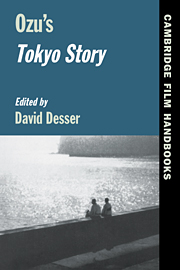Book contents
- Frontmatter
- Contents
- List of Contributors
- Introduction: A Filmmaker for All Seasons
- 1 Ozu's Tokyo Story and the “Recasting” of McCarey's Make Way for Tomorrow
- 2 Travel Toward and Away: Furusato and Journey in Tokyo Story
- 3 Ozu's Mother
- 4 Buddhism in Tokyo Story
- 5 Sunny Skies
- Filmography
- Reviews of “Tokyo Story”
- Select Bibliography
- Index
4 - Buddhism in Tokyo Story
Published online by Cambridge University Press: 16 January 2010
- Frontmatter
- Contents
- List of Contributors
- Introduction: A Filmmaker for All Seasons
- 1 Ozu's Tokyo Story and the “Recasting” of McCarey's Make Way for Tomorrow
- 2 Travel Toward and Away: Furusato and Journey in Tokyo Story
- 3 Ozu's Mother
- 4 Buddhism in Tokyo Story
- 5 Sunny Skies
- Filmography
- Reviews of “Tokyo Story”
- Select Bibliography
- Index
Summary
Early attempts to link Ozu's films with Zen Buddhist aesthetics have been joined by later efforts to link his work with traditional Japanese art forms, many of which were inspired by Zen. David Bordwell's objection to the early critiques – that they were too general and failed to take into account that Japanese aesthetics are varied and that Buddhism has changed its emphasis throughout Japanese history – is only partly convincing. True, the aesthetics of Buddhism in Japan have changed with history, but its artifacts remain, as do its basic philosophical contours, which even today influence thought, behavior, and institutions in Japan. Ronald Philip Dore lists various “elements of Buddhist thought … so thoroughly absorbed into Japanese culture that they no longer depend on Buddhist institutions for their perpetuation” – among them, “the high value placed on the state of non-self,” certain aesthetic values related to Zen, and a “fatalistic determinism emphasizing the necessity of resigned acceptance of one's lot.”
Bordwell's insistence that Ozu evinced little interest in Buddhism is likewise only partly true. During his war service in China, Ozu is reported to have asked a Chinese monk to write the Chinese character mu for him. Mu is an aesthetic term meaning “void,” an emptiness that is nevertheless full of possibilities, such as the empty spaces in a traditional ink-brush painting or the spaces between the branches and flowers in an ikebana arrangement.
- Type
- Chapter
- Information
- Ozu's Tokyo Story , pp. 101 - 117Publisher: Cambridge University PressPrint publication year: 1997
- 37
- Cited by

